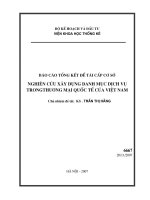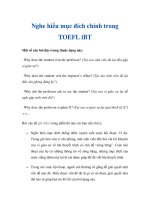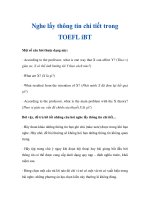Nghe hiểu mục đích chính trong TOEFL iBT pdf
Bạn đang xem bản rút gọn của tài liệu. Xem và tải ngay bản đầy đủ của tài liệu tại đây (127.28 KB, 4 trang )
Nghe hiểu mục đích chính trong
TOEFL iBT
Một số câu hỏi đặc trưng thuộc dạng này:
· Why does the student visit the professor? (Tại sao sinh viên đó lại đến gặp
vị giáo sư?)
· Why does the student visit the registrar’s office? (Tại sao sinh viên đó lại
đến văn phòng đăng ký?)
· Why did the professor ask to see the student? (Tại sao vị giáo sư lại đề
nghị gặp sinh viên đó?)
· Why does the professor explain X? (Tại sao vị giáo sư lại giải thích là X?)
.v.v…
Bởi vậy để ghi điểm trong phần thi này các bạn cần chú ý:
Nghe hiểu mục đích thống nhất, xuyên suốt cuộc hội thoại. Ví dụ:
Trong giờ làm việc ở văn phòng, một sinh viên đến hỏi xin lời khuyên
của vị giáo sư về bài thuyết trình có chủ đề “sông băng”. Cuộc hội
thoại của họ có những thông tin về sông băng, nhưng mục đích của
cuộc viếng thăm này lại là xin được giúp đỡ để viết bài thuyết trình.
Trong các cuộc hội thoại, người nói thường cố gắng để giải quyết một
vấn đề nào đó. Hiểu được vấn đề đó là gì và nó được giải quyết như
thế nào sẽ giúp bạn trả lời tốt câu hỏi dạng này.
Ví dụ: (Narrator) Listen to a conversation between a professor and a student.
Student: I was hoping you could look over my note cards for my
presentation … just to see what you think of it.
Professor: Okay, so refresh my memory: what’s your presentation about?
Student: Two models of decision making …
Professor: Oh, yes – the classical and the administrative model.
Student:Yeah, that’s it.
Professor: And what’s your point of your talk?
Student: I’m gonna talk about the advantages and disadvantages of both
models.
Professor: But what’s the point of your talk? Are you going to say that
one’s better than the other?
Student: Well I think the administrative model’s definitely more realistic.
But I don’t think it’s complete. It’s kind of a tool … a tool to see what can
go wrong.
Professor: Okay, so what’s the point of your talk? What are you trying to
convince me to believe?
Student: Well, uh, the classical model- you shouldn’t use it by itself. A lot
of companies just try to follow the classical model, but they should really
use both models together.
Professor: Okay, good. So let me take a look at your notes here … Oh
typed notes ,,, Wow you’ve got a packed in here. Are you sure you’re going
to be able to follow this during your talk?
Student: Oh, sure that’s why I typed them, because otherwise … well my
handwriting’s not very clear.
Question: Why does the student visit the professor?
A. To get some note cards for his presentation
B. To show her some examples of common errors in research
C. To review the notes for his presentation with her
D. To ask for help in finding a topic for his presentation
Đáp án chính xác là phương án lựa chọn thứ 3. Phần lớn nội dung trong cuộc
hội thoại đề cập đến nội dung về phần trình bày của người sinh viên (two
models of decision making) cùng những thông tin có liên quan. Ta có thể
loại trừ ngay phương án thứ tư vì sinh viên này đã có đề tài cho bài thuyết
trình và chinh giáo sư cũng đã biết tên đề tài đó (the classical and the
administrative model). “Bẫy” của câu hỏi này nằm ở chỗ có tận 3 phương
án đều có vẻ trùng khớp với thông tin được nêu ra trong bài. Tuy nhiên, nếu
bạn tỉnh táo sẽ phát hiện phương án đầu tiên “có vấn đề”. Sinh viên này đến
gặp để nhờ cô giáo look over his note cards chứ không phải “get some
notecards for his presentation”. Mà động từ có nghĩa gần nhất với “look
over” là “review”. Vì vậy câu trả lời chính xác cho câu hỏi “Why does the
student visit the professor? ” phải là phương án lựa chọn thứ 3: “To review
the notes for his presentation with her”.









